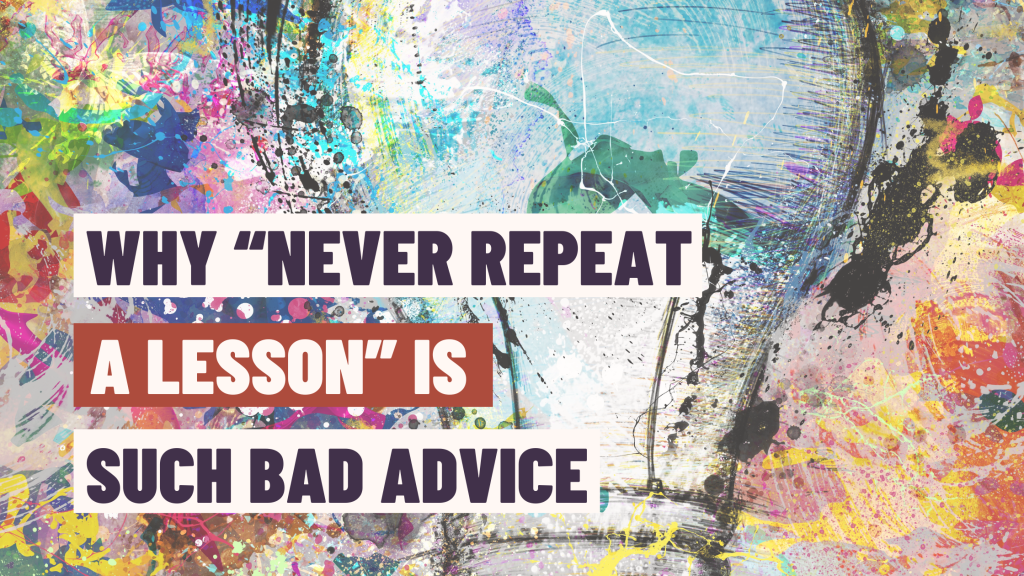I have a bone to pick with Creative Teaching.
Last week, a first-year teacher confided something that broke my heart: “I feel like a bad teacher because I used the same discussion structure twice.” Not only is this misguided, this genuinely creative teacher felt inadequate because she was not brand new every single class period.
Somewhere along the way, we’ve created this myth that good teachers are endlessly creative, constantly generating new activities, never repeating lessons. You see it everywhere:
- Pinterest boards overflowing with elaborate new projects
- Instagram reels showcasing flashy lesson ideas
- Teaching blogs promoting “fresh takes” on everything
- Conference sessions promising revolutionary approaches
- Department meetings celebrating novelty over mastery
Ugh. Never repeat lessons is such bad advice. This is a key cause of burnout and we’ve spread this lie. In fact, many students find this lack of consistency confusing and they are uncomfortable never knowing what to expect in English class.

Table of Contents
The “Creative Teacher” Mythology
The pressure to be an endlessly creative teacher comes from a well-meaning place. We want:
- Engaged students who aren’t bored
- Dynamic lessons that excite
- Professional growth that matters
- Teaching practice that stays fresh
- Classrooms that inspire learning
But here’s what I’ve noticed after all these years in the classroom: Our most powerful teaching moments often come from refined practice, not constant reinvention. Looking back at my teaching journals it’s wild (and oddly reassuring) that I can see echoes of my earliest attempts in my most recent assignments.
Is it creative teaching? Yes. But I’ve had lots of iterations of good ideas.
What Other Experts Know
Think about any field requiring true expertise:
- Do chefs create entirely new recipes every night?
- Do athletes never repeat the same plays?
- Do musicians avoid practicing familiar pieces?
- Do surgeons reinvent procedures constantly?
- Do architects design completely new structures each time?
No. They get better by:
- Refining what works through iteration
- Mastering core techniques deeply
- Building reliable systems thoughtfully
- Understanding principles thoroughly
- Adapting proven approaches strategically
Yet somehow in teaching, we’ve decided that repetition is the enemy of good practice.
The Hidden Costs of the “Creative Teacher” Trap
When we pressure ourselves to constantly create new activities:
- We drain energy that could go to actual teaching improvement
- We lose the deep benefits of refinement and mastery
- We prioritize surface novelty over effective learning
- We prevent true expertise from developing
- We create unsustainable expectations
- We model performance over growth
What Actually Makes Teaching Better
The most effective teachers I know focus on:
1. Building Adaptable Frameworks
- Creating structures that flex for different contexts
- Designing systems that scale across units
- Developing approaches that adjust for needs
- Engineering practices that evolve with use
2. Mastering Core Practices
- Deepening understanding of what works
- Strengthening reliable techniques
- Refining essential strategies
- Building genuine expertise
3. Strategic Innovation
- Adding thoughtful variations
- Making purposeful adjustments
- Incorporating meaningful changes
- Growing through intention
What This Looks Like in Practice
Let me share what this shift looks like in my own classroom. My first year of teaching, my first text was The Odyssey, I felt compelled to create brand new activities for every scene. I spent hours designing clever games, unique projects, and “fresh” discussion formats. I was exhausted, and ironically, my lessons weren’t actually getting better.
Now I have a core set of analytical frameworks that I use across multiple texts. For example:
- A reliable discussion structure that builds real expertise
- A pattern-tracking system that deepens analysis
- A character development framework that reveals meaning
- A theme-exploration approach that creates insight
I use a similar set of lessons in my automated Sub Pan freebie – get this…and 9 other free sub plans…right here!
But here’s what makes them work: They get better every time I use them. Each iteration reveals:
- New ways to support student thinking
- Better questions to drive discussion
- Clearer paths to understanding
- Stronger analytical moves
The focus isn’t on making each lesson different – it’s on making each implementation stronger. Students aren’t bored because the structure is familiar. They’re actually more engaged because they can focus on deeper thinking instead of constantly learning new procedures.
Moving Beyond the Novelty Trap
Does this mean never try anything new? Of course not. But there’s a crucial difference between:
- Strategic innovation vs. constant creation
- Thoughtful adaptation vs. endless novelty
- Systematic growth vs. perpetual reinvention
- Sustainable practice vs. continuous performance
- Mastery development vs. surface creativity
And here’s the beautiful irony: When you stop pressuring yourself to reinvent everything constantly, you actually have the mental space and energy to be genuinely creative where it matters.
Want to build teaching practices that actually get better over time? Start with my free Energy-Aligned Teaching Guide to learn how to:
- Create reusable frameworks that evolve
- Develop adaptable systems that grow
- Build on proven success strategically
- Engineer sustainable teaching practices
Great teaching isn’t about constant novelty – it’s about getting better at what truly matters for student learning.



